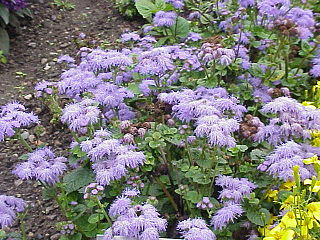
Eupatorieae is a tribe of over 2000 species of plants in the family Asteraceae. Most of the species are native to tropical, subtropical, and warm temperate areas of the Americas, but some are found elsewhere. Well-known members are Stevia rebaudiana, a number of medicinal plants (Eupatorium), and a variety of late summer to autumn blooming garden flowers, including Ageratum (flossflower), Conoclinium (mistflower), and Liatris.
Adenocritonia is a genus of flowering plants in the family Asteraceae described as a genus in 1976.
Amolinia is a genus of flowering plants in the family Asteraceae, described as a genus in 1972.
Brickelliastrum is a North American genus of flowering plants in the tribe Eupatorieae within the family Asteraceae. Brickelliastrum has at times been lumped with Brickellia or Steviopsis, but chromosome number (x=10) and molecular data are in agreement in showing that it is distinct from either of these. Despite having the general appearance of Brickellia, members of Brickelliastrum have cypselae that have only 5-7 ribs, funnel-shaped corollas, and a style with an unenlarged, glabrous base.
Critoniadelphus is a genus of flowering plants in the family Asteraceae.
Decachaeta is a genus of Mesoamerican flowering plants in the family Asteraceae.
Erythradenia is a genus of flowering plants in the family Asteraceae.
Fleischmanniopsis is a genus of Mesoamerican flowering plants in the family Asteraceae.

Gymnocoronis is a genus of flowering plants in the family Asteraceae.

Hofmeisteria is a genus of Mexican flowering plants in the family Asteraceae.
Kyrsteniopsis is a genus of Mexican flowering plants in the family Asteraceae.
Macvaughiella is a genus of Mesoamerican flowering plants in the tribe Eupatorieae within the family Asteraceae.

Microspermum is a genus of Mexican flowering plants in the tribe Eupatorieae within the family Asteraceae.
Nesomia is a genus of flowering plants in the tribe Eupatorieae within the family Asteraceae.
Oxylobus is a genus of Mesoamerican flowering plants in the tribe Eupatorieae within the family Asteraceae.
Pachythamnus is a genus of Mesoamerican flowering plants in the tribe Eupatorieae within the family Asteraceae.

Peteravenia is a genus of Mesoamerican plants in the tribe Eupatorieae within the family Asteraceae.

Piqueria is a genus of Caribbean and Mesoamerican plants in the tribe Eupatorieae within the family Asteraceae.
Revealia is a genus of Mexican plants in the tribe Eupatorieae within the family Asteraceae. The only known species is Revealia macrocephala, native to the Mexican State of Guerrero.
Steviopsis is a genus of Mexican plants in the tribe Eupatorieae within the family Asteraceae.





